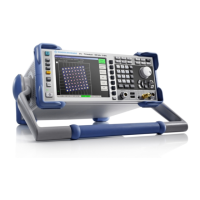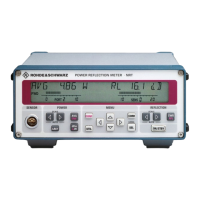Two-port measurements with the tracking generator R&S FSH
1309.6275.12 4.50 E-2
Press the AMPT key.
Press the REF LEVEL softkey.
Change the reference using the rotary knob or the
cursor keys, or enter a new reference via the
numeric keypad.
Confirm the entry with the ENTER key or the REF
LEVEL softkey.
When performing measurements on amplifiers, make sure the R&S FSH is not overdriven. The risk of
overdriving is eliminated when the trace is within the display area on the screen (with REF POSITION =
10 dB).
The reference can also be shifted without increasing the input attenuation – for example, in order to
move the trace to the center of the screen. This is done using the REFPOS function. The values 0 to 10
indicate the horizontal lines from bottom to top (with 0 = bottom line, 10 = uppermost line). The value 5
indicates the center line of the diagram.
Press the AMPT key.
Press the REFPOS softkey.
Change the reference position using the rotary knob
or the cursor keys, or enter a new reference position
via the numeric keypad.
Confirm the entry with the ENTER key or the
REFPOS softkey.
Vector measurement
(Only for R&S FSH4/8 with tracking generator and integrated VSWR bridge (order number
1309.6000.24 or 1309.6000.28) and R&S FSH-K42 (vector reflection and transmission measurement)
option installed in conjunction with R&S FSH-Z28 or R&S FSH-Z29 (calibration standards)).
With vector measurements, the R&S FSH analyzes both magnitude and phase of the receive signal,
thus correcting the influence it has on the measurement result by means of the complex correction
values obtained from the calibration types with correct phase. Reference is made to the calibration
standards used (through connection and 50 termination).
Compared to scalar measurement, the vector transmission measurement yields higher measurement
accuracy and dynamic range. One of the main benefits of vector measurement is that it also lets you
determine the phase, group delay and electrical length of a DUT. These measurements are possible
only after calibration has been performed; they remain disabled (command dimmed) until this is done.
For vector measurements, the following calibration types are available.

